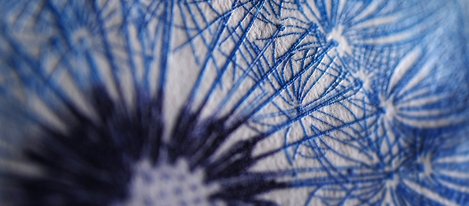

Sustainability at every level
G+D's solution for more and greater sustainability: the Green Banknote, a Hybrid ADDvance® banknote with the lowest carbon footprint but with no compromise on durability and security. A core with a green heart, a minimized use of plastic, and still maximum confidence through security from within. “It is a contribution to a more sustainable future and higher public acceptance for cash as a preferred means of payment,” says Felix Ehrtmann, G+D's Product Manager Integration + Print. An interview.
Following the Green Banknote Initiative launched in spring, G+D has now presented the Green Banknote. Why?
Because the Green Banknote is an integral part of our “Green Banknote Initiative”; it fits seamlessly into the concept of “Durability+” and thus demonstrates not only what is already possible, but also what kind of action-fields will result from it in the future. In other words, we are taking the product “banknote” to a higher level by working with new types of locally grown fibers, certified organic cotton and recycled materials, by optimizing the use of innovative products, or by using environmentally friendly printing inks. At the same time, however, we are proving that we not only see and analyze potential for improvement but can also implement it with our existing processes – without having to reinvent the basic concept or for example foil-based security features from scratch.
In addition to the virtual platform of the Green Banknote Initiative, the note itself makes sustainability “tangible” in the literal sense of the word?
Yes, we make it tangible, concrete, and applicable. But above all: doable! See: what a bunch of nice ideas and empty phrases, greenwashing and greenbashing are out there? For us, on the other hand, it was always a clear prerequisite that we could run our Green Banknote through our standard processes and aggregates. And that the demand for more sustainability – which, like everywhere else in the economy, is also brought to us by the market – is met.

So let's get specific: What does the Green Banknote achieve?
In the Green Banknote, for the first time ever in banknotes, the carrier foil for the security thread and the security patch are made of 70% recycled polyester from post-consumer recycled materials such as PET bottles. Further, we have reduced the foil thickness for the protective layer in Hybrid™ substrate from 6μm to 4μm, that is, about one-tenth of a human hair. This leads to 86% less plastic compared to banknotes made from polymer. In addition, for the first time mineral oil-free printing inks are used, with a corresponding reduction in the use of fossil raw materials and increase of the bio-based content. And finally, the Green Banknote builds on our proven Hybrid ADDvance® concept.
Which means?
We continue to use a core based on natural renewable fibers, which – and this is completely new – consists of 50% cotton from certified sources of organic cultivation and 50% European grown fibers from FSC® (FSC-C138716) certified wood pulp from responsible forestry. This leads to a massive reduction of carbon emission compared to conventional cotton fibers. In combination with the thin lamination film which protects the paper core but also the security foils and threads, the Green Banknote achieves the same lifespan as polymer banknotes.
From a recyclate we create something with far greater value

What were the biggest challenges?
The overall complexity. The Green Banknote is a highly complex, demanding product in terms of production and materials – from the paper core to the application of the patch to the lamination process and the various printing steps. Despite the complexity, the results are impressive: As the leading product in terms of sustainability today, it generates 29% less CO2 than finished polymer banknotes. At the same time, its circulation performance will be similar to our standard Hybrid™ banknotes offering the same lifespan as polymer banknotes. Nevertheless, one thing always remains of the highest standard: security. Like all fiber-based substrates, the Green Banknote can be equipped with all state-of-the-art substrate embedded security features such as the RollingStar® i+ security thread.
Wouldn't it have been time for such a product much earlier?
Sustainable thinking and acting can't begin soon enough. Nevertheless, we naturally only work with certain qualities. Sure, recycled polyester is nothing new now, but if it becomes “cloudy” and doesn't have the brilliance, then it's unusable for us. Today, we meet these high-quality expectations with our Green Banknote.
With the result of a product that is as suitable for everyday use as it is sustainable?
Yes, which also corresponds to the claim of “upcycling”, i.e. an actual material upgrading: while others create disposable flower pots from plastic waste, we create security threads and patches for banknotes from used plastic bottles, for example. From a recyclate, we thus create something with far greater value and, with the Green Banknote, make a decisive contribution to greater environmental protection and sustainability – which not only meets the demand for “less plastic”: the Green Banknote supports our customers and partners with all our knowledge and capabilities on their way to green banking.
NEWS
Fresh new member of "Team Green": Green LongLife™

A more sustainable cash cycle is the goal of every central bank – and as a leading provider of banknotes based on natural renewable fibres, we are constantly working to improve all our products and make them even more sustainable.
With Green LongLifeTM, we have succeeded in further increasing the amount of renewable raw materials in a particularly durable banknote substrate. At the same time, we reduced the content of mineral oil-based materials such as plastic to an absolute minimum and opted for mineral oil-free inks. With Green LongLife, we have retained the well-known strengths –and decisively improved sustainability once again.
Alternative fibres such as organic cotton or Cotton made in Africa (CmiA) can be selected for substrate production. The Galaxy® security thread and RollingStar® LEAD Mix film now use 70% recycled polyester, and the biobased carbon content is > 85%.
Green LongLife delivers unmatched security from within, offering the possibility of being protected with the most advanced security features.
Advantages of Green LongLife:
- High biobased carbon content by using natural fibres
- Pre-coating based on natural raw materials
- Mineral oil-free inks
- Reduced carbon emissions with the use of certified organic cotton
- High durability achieving up to 2x lifetime compared to standard banknotes
- Unmatched security from within utilising substrate-embedded L1, L2 and L3 Features
- Numerous possibilities for repurposing – from Banknote Fibre Extraction to composting and many more

Further Reading
The Green Banknote Initiative
As a leading company in the industry, we take sustainability seriously. Based on a study that took a close look at banknote substrates, we have broadened our focus on the subject of sustainable banknotes.
Green LongLifeTM banknote paper
Durable pre-coated substrates make banknotes more sustainable by reducing the need for frequent reprints – and support central banks in operating more efficiently. With Green LongLife, we have succeeded in preserving the well-known qualities of LongLife while significantly enhancing sustainability.